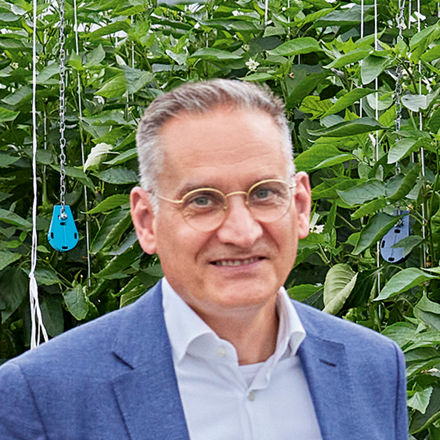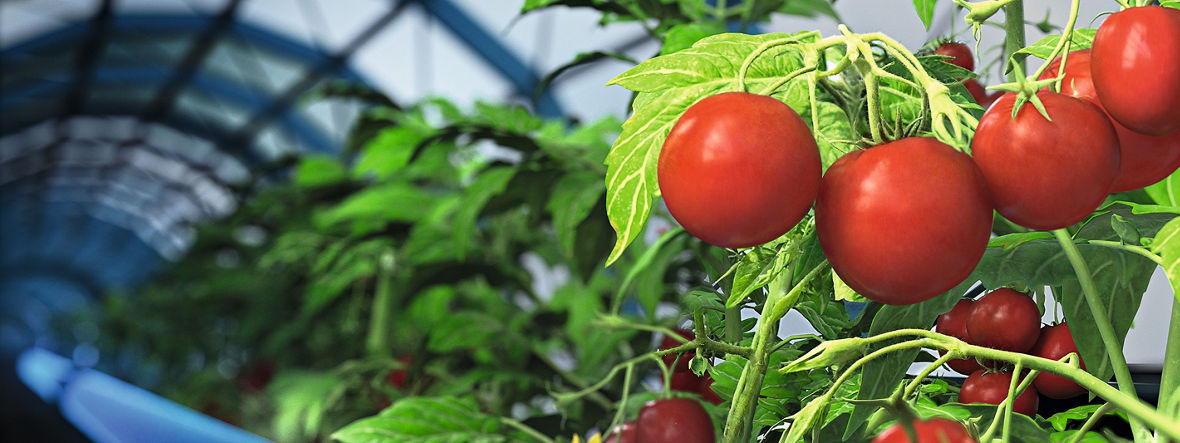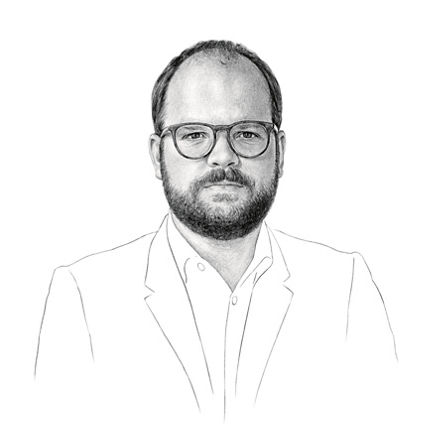The natural enemies of the tomato plant have exotic names, such as Pythium, Fusarium, Xanthomonas, Rhizobium, and tomato brown rugose fruit virus (ToBRFV). And they lurk everywhere. “The tobacco mosaic virus, for example, could be carried into our greenhouse unnoticed on any smoker’s hands,” says vegetable grower Tobias Jörg. “Then there is a risk of total failure, the fruit becomes unsaleable, the plants die, all of them.” That’s why every walk in Jörg’s greenhouse leads through a digitally monitored hygiene sluice, whose brush floor moistens the soles of shoes with disinfectant. Hand cleaning and disinfection are also mandatory before the turnstile allows access.
There is a great deal at stake: The greenhouse at Reichenauer Gärtnersiedlung in Singen near Lake Constance is 13 hectares in size, the equivalent of around 18 soccer fields under glass. Jörg and four co-founders established the company together in 2011. All five come from families that have grown vegetables for generations—but never on this scale: The five harvest around 900 tons of tomatoes, 2,000 tons of peppers, and three million eggplants here every year. Conditions are far different from those of the small farms of their parents and grandparents. Irrigation, fertilization, ventilation, heating—everything is automated here. The valuable fruits are harvested and packed by hand until well into November. This is followed by a thorough cleaning of the greenhouse and a final disinfection a few days later, before new plants are planted in January. “Once, in 2018, a Fusarium infestation extended from one year to the next,” recalls Jörg, who doesn’t want this to happen ever again.

Hygiene is extremely important in this state-of-the-art food production center. “The recirculating water in closed systems such as greenhouses enables pathogens to quickly spread everywhere,” explains Achim Marx. “Almost the only way you can deal with such a situation is with pesticides—if at all. That’s why we are working on preventative hygiene solutions to contain the spread of germs from the outset.” Marx is no farmer, but a trained biotechnologist who now works as a digital expert at Evonik Digital GmbH in Essen. Since 2017, the subsidiary has been developing new, digital business areas on behalf of the specialty chemicals company—including in agriculture.
On the path to the Internet of Things
“Big data analyses allow us to better understand systems such as a barn, an animal organism or a greenhouse,” explains Marx. “This makes it possible to anticipate disruptive factors such as diseases and then take countermeasures earlier, more effectively, and usually much more gently.” This applies to animal production, where digital solutions from Evonik are already helping to improve the feed, intestinal health, and general well-being of pigs, chickens, and salmon in such a way that antibiotics, for example, become superfluous. Now digitalization is also set to protect tomatoes, lettuce, and other vegetables.
Evonik was recently nominated for the German Innovation Award for the holistic solution it has been developing since 2022. It combines knowledge from Evonik and the company’s own products for water hygiene with know-how from agricultural practice and new developments in areas such as big data and genetic analysis. Internet of Things connections, which allow telemetric remote monitoring and were developed in close cooperation with Siemens Digital Industries, are of great importance here.

»Process automation and remote monitoring allow us to offer water hygiene as a service«
Stephan Neumayer Senior Manager, Business Development Active Oxygens at Evonik
Perhaps the most important innovation for Evonik itself, however, is the underlying business model. “We’ve managed to greatly automate and digitally optimize the monitoring of germs in the water as well as the countermeasures,” says Marx. “As a result, we can offer vegetable growers water hygiene as a service.”
The hardware essentially consists of a digitally controlled dosing unit with which infinitesimally small but effective quantities of an active substance such as hydrogen peroxide from Evonik can be fed into a water circuit.
This could be a watering system for a chicken farm or drip irrigation in a large tomato greenhouse. Quantities in the parts-per-million range, i.e. less than one thousandth of a percent, are sufficient to eliminate harmful germs.
By comparison, pharmacies offer hydrogen peroxide over the counter in a three percent concentration as a mouthwash for gargling.


Complex technology made easy
The special feature of Evonik’s new solution is that the dosing is intelligently controlled: Sensors collect water data in real time and complex data analyses help to determine the optimum dosage. This includes environmental parameters, information on operating processes and, in the future, cytometric analyses—i.e. precise determinations of germs. Sensors and dosing units communicate wirelessly via the Internet of Things. This allows Evonik to monitor all data centrally and let the system learn. “The user is completely unaware of this complexity. It remains simple for him,” says Marx. “At the same time, our system learns on its own and guides users through the handling in a very straightforward way.”
This aspect shouldn’t be underestimated. “We are also meeting the demand for process reliability and convenience,” says Frank von der Haar, with whom Evonik collaborated to develop this “all-round carefree package”. “Nobody wants to worry about water hygiene. This often only changes when something goes really wrong,” says von der Haar, an engineer based near Osnabrück.
He knows this field inside out. He set up his own business around 20 years ago with systems for water disinfection in agriculture and sells them throughout Germany. “Word gets around when someone suddenly achieves significantly better results through water hygiene alone,” he says. Marx didn’t come across von der Haar and water hygiene entirely by chance. Marx had previously visited several farms for his Essen-based employer. “I kept noticing this sticker,” he says. “It said: Agricultural hygiene—water technology—Frank von der Haar.”
This sticker can also be found in Singen. There, von der Haar helped to get the Fusarium outbreak at Tobias Jörg’s greenhouse under control in 2018. Today, irrigation is carried out almost exclusively using rainwater, which is caught by the glass roof, collected in three large ponds, and disinfected with UV light. “For us, the automated solution from Evonik is an interesting further development in water hygiene,” says Jörg. “Above all, it’s interesting to know which pathogens in the water you need to ramp up your defenses against.” To make this possible, Evonik worked with the University of Applied Sciences and Arts Northwestern Switzerland in Basel to demonstrate how the “fingerprint” of certain harmful germs in water can be determined almost in real time.

Using a PCR device and a flow cytometer, Rhizobium rhizogenes could be identified accurately and almost fully automatically in the water. The bacterium is responsible for crazy roots syndrome, in which plants suddenly develop uncontrolled roots. “If we know what we are dealing with, we can take more effective countermeasures,” says Jörg. “After all, not every germ is equally problematic. But by the time we have to send in samples and wait for results, it’s usually too late.”

Focusing on roots
At Forschungszentrum Jülich (FZJ) near Aachen, the causes of pest infestations are being investigated further. In the research greenhouse of the Institute of Plant Sciences, Professor Ulrich Schurr and his team of 170 people are working on new concepts for more sustainable agriculture. “New and improved cultivation methods can help to produce food more sustainably and, most importantly, to adapt production to changing conditions, such as climate change,” explains Schurr. The work in the research greenhouses extends from the German sugar beet to the “tropical potato” manioc. Schurr has just given a delegation from East Africa a tour of the experimental facilities.
One of the scientists’ specialties is the hidden life of plants underground—the “hidden half”, as they call it here. “We don’t just look at the shoot, by which I mean everything that grows aboveground, but instead take an especially close look at the roots,” says Schurr. To this end, his team uses technologies that allow them to watch the roots grow and even track the flow of water and nutrients within the roots. The Jülich Rhizotron facility is unique. It consists of almost 1,000 diagonally arranged plant containers with a transparent base and several robots that move back and forth between them. The roots of the plant grow downwards along the pane. Several times a day, the robots take each container out of the facility in order to take a high-resolution photo of it.
Using tens of thousands of such images and AI-assisted image analysis, Dr. Vitalij Dombinov is researching, for example, how to make a fertilizer derived from sugar cane ash—an abundant agricultural residue in Brazil—palatable to the country’s crops. MRI and PET machines are located next to the facility. Both methods, magnetic resonance imaging and positron emission tomography, are otherwise more familiar from medicine. In Jülich, the researchers are using it to show, for example, how beets grow, how they store carbon in the form of sugar, and how certain diseases hinder this process.
On behalf of Evonik, the scientists in Jülich are now testing what Evonik’s innovative service approach can do for plant and root health. The goal is not just to obtain scientific evidence—the FZJ is an important interface to practical applications. “We translate research findings into practical recommendations and methods for agriculture,” explains Dr. Arnd Kuhn, one of the most experienced members of Professor Schurr’s team. The FZJ regularly works with horticulturalists, farmers, and breeders in the region to test such new technologies under real-life conditions.
ELEMENTS-Newsletter
Receive exciting insights into Evonik's research and its social relevance - conveniently by e-mail.
A job for hydrogen peroxide
The experiments also include the use of hydrogen peroxide to combat germs. “Our new approach works with any standard disinfectant,” says Stephan Neumayer. “But hydrogen peroxide has clear ecological advantages.”
Neumayer is a senior manager in Business Development at Active Oxygens, the Evonik business line that primarily produces hydrogen peroxide. With an annual capacity of over one million tons and around 20 production sites, Evonik is one of the world’s largest manufacturers of hydrogen peroxide.
This compound of two hydrogen and two oxygen atoms reliably decomposes harmful germs and breaks down into water and oxygen. “This means that no harmful residues remain, as can be the case with some other disinfectants,” says Neumayer.
For this reason, hydrogen peroxide is used as an environmentally friendly bleaching agent in paper and pulp production. It is also frequently used as a disinfectant in the food industry and even as a sustainable rocket fuel in civil space travel.

At Jülich, the hydrogen peroxide required is produced in the research greenhouse itself. A refrigerator-sized device from HPNow is sufficient for this. It is the latest generation of devices from the Danish manufacturer, in which Evonik has held a stake since 2017.
Inside, a catalyst is used to produce one percent hydrogen peroxide. All you need is air, a water connection, and a power socket. “The quantities that the device delivers are completely sufficient for this application,” says Neumayer.
“We are not primarily interested in large new sales markets for hydrogen peroxide.” Instead, Evonik markets water hygiene as a service at an all-inclusive price. For a fixed amount per cultivation cycle, the specialty chemicals company ensures that the water remains “clean”.
“This way of thinking is still young in a company that has been manufacturing and selling chemical products for generations,” says Neumayer. But the trend is towards “anything as a service”. Instead of just chemical products, Evonik will market the complete solution as a package, consisting of product, technology, and know-how.

Sustainability on the plate
With this package solution, Evonik is also accommodating an important trend in agriculture and food production. Cultivation methods must become more sustainable, adapt to changing climatic conditions, and at the same time meet high consumer demands. Conventional cultivation requires vast areas, lots of water, large amounts of fertilizer, and usually pesticides. Organic farming is considered more environmentally friendly, but requires more land because the yields are lower. Because consumers also expect flawless vegetables and a full range of products throughout the year, there is a lot of waste and long transportation routes. Asparagus flown in from South America pollutes the climate, but so does every locally produced head of lettuce that ends up limp in the trash.
Controlled environment agriculture (CEA) could offer a solution. CEA includes high-tech greenhouses like the one at Lake Constance, in which nutrients, irrigation, temperature, humidity, and much more are tailored as perfectly as possible to the needs of crops such as lettuce, tomatoes, peppers, and eggplants. In many cases, CEA even manages without soil because the nutrient solution flows directly around the roots of the plants. Instead of the sun, LEDs provide the light—and always in the optimal wavelengths for each growth cycle. In vertical farming, the plants grow on multiple levels above one another to save space.

At 31,000 square meters, the world’s largest vertical farm is currently located in Dubai. Lettuce and other leafy vegetables thrive here all year round on huge shelves, while the sun broods over the desert outside. Until now, the Emirates have imported around 90 percent of their food. Locally produced vegetables could be a more sustainable addition, despite the high complexity of vertical farming. More and larger vertical farms are already being planned, and Siemens equipment is installed in many of them. “But shorter transportation routes are also needed in our conurbations here in Europe,” says Schurr. Vertical farming would also be an opportunity specifically for the structural transformation of the Rhenish lignite mining region. Moreover, water scarcity is increasingly becoming an issue here as well.
Smart countermeasures
Vertical farms can save 95 percent or more water. After all, nothing seeps away and even every drop that evaporates is fed back into the cycle. That’s how the farm in Dubai saves around 250 million liters of water per year compared to conventional cultivation. “These cycles are highly efficient, but also mean that the same water flows around practically every root,” explains Marx. “In the worst case scenario, harmful germs quickly spread across the entire cultivation area.”
Tobias Jörg also likes the idea of being rid of this worry once and for all—with guaranteed germ prevention practically on subscription and digitally at the touch of a button. So far, the water cycle in Singen has been disinfected with UV light and by the company itself. However, the facility is slowly getting on in years. And it certainly doesn’t learn on its own. “At the same time, we are now dealing with ever new and increasingly resistant pathogens from all over the world,” says Jörg. ToBRFV, for example, which tomato growers fear, was only detected in Germany for the first time in 2018. So it’s high time for a smart countermeasure that works preventively, is tailored to plants, processes, cultivation parameters, and the actual amount of germs—and is also fit for future challenges thanks to digitalization, big data, and artificial intelligence.



